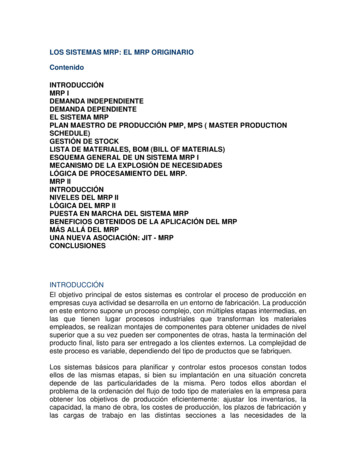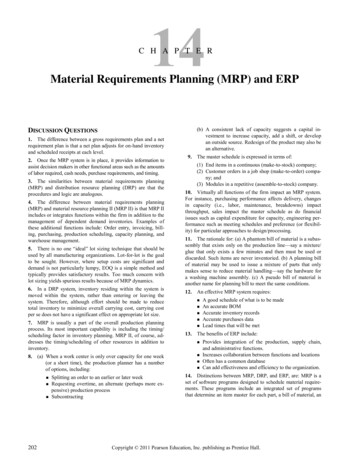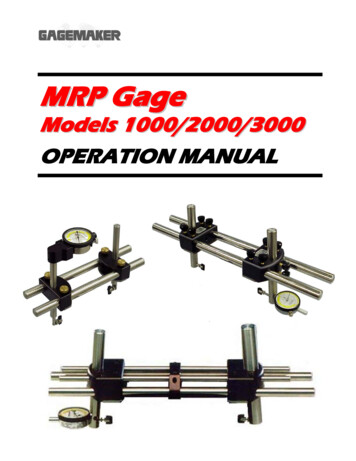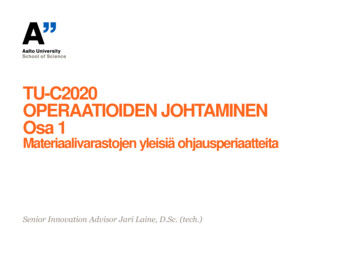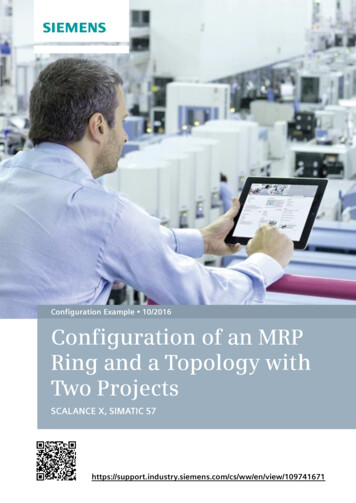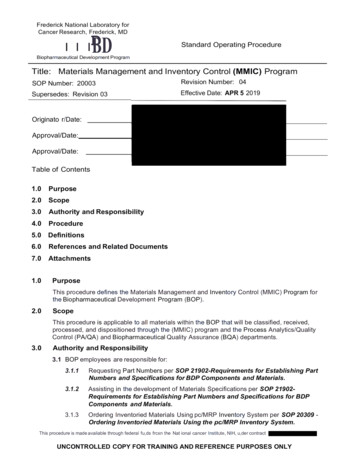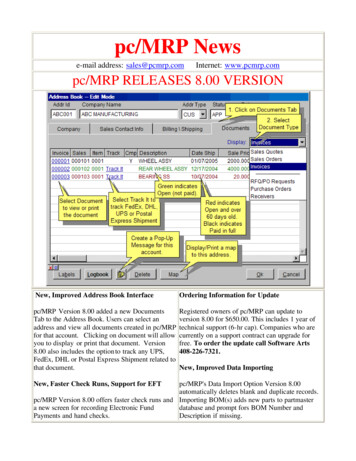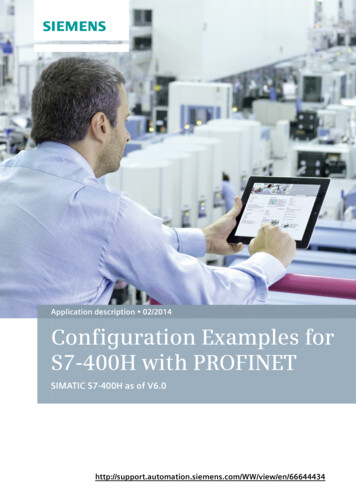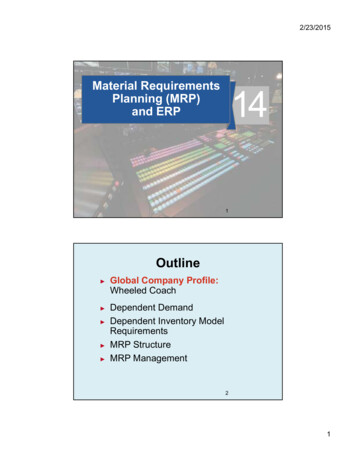
Transcription
2/23/2015Material RequirementsPlanning (MRP)and ERP141Outline Global Company Profile:Wheeled CoachDependent DemandDependent Inventory ModelRequirementsMRP StructureMRP Management21
2/23/2015Outline - Continued Lot-Sizing TechniquesExtensions of MRPMRP In ServicesEnterprise Resource Planning (ERP)3Learning ObjectivesWhen you complete this chapter youshould be able to:1. Develop a product structure2. Build a gross requirements plan3. Build a net requirements plan4. Determine lot sizes for lot-for-lot, EOQ,and POQ42
2/23/2015Learning ObjectivesWhen you complete this chapter youshould be able to:5. Describe MRP II6. Describe closed-loop MRP7. Describe ERP5MRP for Wheeled Coach Largest manufacturer ofambulances in the world International competitor 12 major ambulance designs 18,000 different inventory items 6,000 manufactured parts 12,000 purchased parts 2014 Pearson Education, Inc.63
2/23/2015MRP for Wheeled Coach Four Key Tasks Material plan must meet both therequirements of the master scheduleand the capabilities of the productionfacility Plan must be executed as designed Minimize inventory investment Maintain excellent record integrity 2014 Pearson Education, Inc.7Dependent DemandFor any product for which a schedulecan be established, dependentdemand techniques should be used84
2/23/2015Dependent DemandBenefits of MRP1. Better response to customer orders2. Faster response to market changes3. Improved utilization of facilities andlabor4. Reduced inventory levels9Dependent Demand The demand for one item is related to thedemand for another item Given a quantity for the end item, thedemand for all parts and components canbe calculated In general, used whenever a schedule canbe established for an item MRP is the common technique105
2/23/2015Dependent Inventory ModelRequirementsEffective use of dependent demandinventory models requires the following1. Master production schedule2. Specifications or bill of material3. Inventory availability4. Purchase orders outstanding5. Lead times11Master Production Schedule(MPS) Specifies what is to be made and when Must be in accordance with the aggregateproduction plan Inputs from financial plans, customer demand,engineering, supplier performance As the process moves from planning toexecution, each step must be tested forfeasibility The MPS is the result of the production planningprocess126
2/23/2015Master Production Schedule(MPS) MPS is established in terms of specific products Schedule must be followed for a reasonablelength of time The MPS is quite often fixed or frozen in thenear term part of the plan The MPS is a rolling schedule The MPS is a statement of what is to beproduced, not a forecast of demand13The Planning ProcessFigure 14.1147
2/23/2015The Planning rdemandFinanceCash flowSupply ChainProcurementSupplierperformanceSales & OperationsPlanningGenerates anaggregate planHuman ResourcesStaff planningMaster productionscheduleFigure 14.115The Planning ProcessMaster productionscheduleMaterialrequirements planChangemasterproductionschedule?Schedule andexecute planFigure 14.1168
2/23/2015AggregateProduction PlanMonthsAggregate Plan(Shows the totalquantity of amplifiers)WeeksMaster Production Schedule(Shows the specific type andquantity of amplifier to beproduced240-watt amplifier150-watt amplifier75-watt ure 14.2561005007810045030045010017Master Production Schedule(MPS)Can be expressed in any of the followingterms:1. A customer order in a job shop (make-toorder) company2. Modules in a repetitive (assemble-toorder or forecast) company3. An end item in a continuous (stock-toforecast) company189
2/23/2015MPS ExampleTABLE 14.1Master Production Schedule for Chef John’s Buffalo ChickenMac & CheeseGROSS REQUIREMENTS FOR CHEF JOHN’S BUFFALO MAC & nd so on19Bills of Material List of components, ingredients, andmaterials needed to make product Provides product structure Items above given level are called parents Items below given level are calledcomponents or children2010
2/23/2015BOM ExampleLevelProduct structure for “Awesome” (A)A0B(2)1E(2)23C(3)E(2)D(2)F(2)G(1)D(2)21BOM ExampleFor an order of 50 Awesome speaker kitsLevelPart B:0 C:PartPart D:Product structure for “Awesome” (A)2 x number of As 3 x number of As A2 x number of BsB(2) 2 x number of Fs 1Part E: 2 x number of Bs 2 x number of Cs PartF:2x numberof Cs E(2)2Part G: 1 x number of Fs 3D(2)(2)(50) (3)(50) 100150(2)(100) (2)(300) 800C(3)(2)(100) (2)(150) 500(2)(150) E(2)F(2)300(1)(300) 300G(1)D(2)2211
2/23/2015Bills of Material Modular Bills Modules are not final products butcomponents that can be assembled intomultiple end items Can significantly simplify planning andscheduling23Bills of Material Planning Bills Also called “pseudo” or super bills Created to assign an artificial parent to theBOM Used to group subassemblies to reduce thenumber of items planned and scheduled Used to create standard “kits” for production2412
2/23/2015Bills of Material Phantom Bills Describe subassemblies that exist onlytemporarily Are part of another assembly and never gointo inventory Low-Level Coding Item is coded at the lowest level at which itoccurs BOMs are processed one level at a time25Accurate Inventory Records Accurate inventory records areabsolutely required for MRP (or anydependent demand system) to operatecorrectly Generally MRP systems require morethan 99% accuracy2613
2/23/2015Purchase Orders Outstanding A by-product of well-managedpurchasing and inventory controldepartment Outstanding purchase orders mustaccurately reflect quantities andscheduled receipts27Lead Times for Components The time required to purchase,produce, or assemble an item For production – the sumof the move, setup, andassembly or run times For purchased items –the time between therecognition of a needand when its availablefor productionTABLE 14.2Lead Times for AwesomeSpeaker Kits (As)COMPONENTLEAD TIMEA1 weekB2 weeksC1 weekD1 weekE2 weekF3 weeksG2 weeks2814
2/23/2015Time-Phased ProductStructureFigure 14.3Must have D and Ecompleted here soproduction can beginon BStart production of D1 weekD2 weeks toproduceB2 weeksEA2 weeks1 weekE1 week2 weeksGC3 weeksF1 week 123D 45678Time in weeks29MRP StructureData FilesBOMFigure 14.4Output ReportsMasterproduction scheduleMRP byperiod reportMRP bydate reportLead timesPlanned orderreport(Item master file)Inventory dataPurchasing dataMaterialrequirementplanningprograms(computer andsoftware)Purchase adviceException reportsOrder early or lateor not neededOrder quantity toosmall or too large3015
2/23/2015Determining GrossRequirements Starts with a production schedule for the enditem – 50 units of Item A in week 8 Using the lead time for the item, determine theweek in which the order should be released –a 1 week lead time means the order for 50units should be released in week 7 This step is often called “lead time offset” or“time phasing”31Determining GrossRequirements From the BOM, every Item A requires 2 ItemBs – 100 Item Bs are required in week 7 tosatisfy the order release for Item A The lead time for the Item B is 2 weeks –release an order for 100 units of Item B inweek 5 The timing and quantity for componentrequirements are determined by the orderrelease of the parent(s)3216
2/23/2015Determining GrossRequirements The process continues through the entireBOM one level at a time – often called“explosion” By processing the BOM by level, items withmultiple parents are only processed once,saving time and resources and reducingconfusion Low-level coding ensures that each itemappears at only one level in the BOM33Gross Requirements PlanTABLE 14.3Gross Material Requirements Plan for 50 Awesome Speaker Kits (As)with Order Release Dates Also ShownWEEK1234567A. Required dateLEADTIME50Order release date50B. Required date1 week100Order release date1002 weeksC. Required date150Order release date150E. Required date200Order release date2001 week3003002 weeksF. Required date300Order release date300D. Required date3 weeks600Order release date600G. Required dateOrder release date82002001 week3003002 weeks3417
2/23/2015ITEMON HANDITEMON HANDA10E10B15F5C20G0D10Net Requirements Plan35Net Requirements Plan3618
2/23/2015Determining Net Requirements Starts with a production schedule for the enditem – 50 units of Item A in week 8 Because there are 10 Item As on hand, only40 are actually required – (net requirement) (gross requirement – on-hand inventory) The planned order receipt for Item A in week8 is 40 units – 40 50 – 1037Determining Net Requirements Following the lead time offset procedure, theplanned order release for Item A is now 40 unitsin week 7 The gross requirement for Item B is now 80 unitsin week 7 There are 15 units of Item B on hand, so the netrequirement is 65 units in week 7 A planned order receipt of 65 units in week 7generates a planned order release of 65 units inweek 53819
2/23/2015Determining Net Requirements A planned order receipt of 65 units in week 7generates a planned order release of 65 unitsin week 5 The on-hand inventory record for Item B isupdated to reflect the use of the 15 items ininventory and shows no on-hand inventory inweek 8 This is referred to as the Gross-to-Netcalculation and is the third basic function of theMRP process39Gross Requirements ScheduleFigure 14.5SABBCLead time 4 for AMaster schedule for APeriods5640PeriodsGross requirements: B789 10 115015121040 10 50CMaster schedulefor Bsold directlyLead time 6 for SMaster schedule for S34089 10 11 12 1340450520620715 30 4513082310 10Therefore, these arethe grossrequirements for B4020
2/23/2015Net Requirements PlanThe logic of net requirementsGrossrequirementsAllocations Total requirements–Onhand ScheduledreceiptsNet requirementsAvailable inventory41MRP Planning SheetFigure 14.64221
2/23/2015Safety Stock BOMs, inventory records, purchase andproduction quantities may not be perfect Consideration of safety stock may be prudent Should be minimized and ultimatelyeliminated Typically built into projected on-handinventory43MRP Management MRP dynamics Facilitates replanning when changes occur System nervousness can result from toomany changes Time fences put limits on replanning Pegging links each item to its parentallowing effective analysis of changes4422
2/23/2015MRP Management MRP limitations MRP does not do detailed scheduling–itplans Works best in product-focused, repetitiveenvironments Requires fixed lead time and infinite sizetime buckets45Lot-Sizing Techniques Lot-for-lot techniques order just what isrequired for production based on netrequirements May not always be feasible If setup costs are high, lot-for-lot can beexpensive Economic order quantity (EOQ) EOQ expects a known constant demand andMRP systems often deal with unknown andvariable demand4623
2/23/2015Lot-Sizing Techniques Periodic order quantity (POQ) ordersquantity needed for a predetermined timeperiod Interval EOQ / average demand per period Order quantity set to cover the interval Order quantity calculated when order isreleased No extra inventory47Lot-Sizing Techniques Dynamic lot sizing techniques Balance lot size and setup costs Part period balancing (least total cost) Least unit cost Least period cost (Silver-Meal) Dynamic programming approach Wagner-Whitin4824
2/23/2015Lot-for-Lot 030ScheduledreceiptsProjected onhand35NetrequirementsPlanned orderreceiptsPlanned orderreleases3040103055Holding cost 1/week; Setup cost 100; Lead time 1 week49Lot-for-Lot ExampleNo on-hand inventory is carried through the systemTotalWEEKholding cost1 023456789GrossThere arerequirementsseven35setupsfor thisitemin this30400104030 plan0Totalorderingcost 7x 100 700Scheduled103055receiptsProjected 5304010403030554030Planned orderreceiptsPlanned orderreleases3040103055Holding cost 1/week; Setup cost 100; Lead time 1 week5025
2/23/2015EOQ Lot Size ptsProjected onhand35NetrequirementsPlanned orderreceipts73Planned orderreleases73737373737373Holding cost 1/week; Setup cost 100; Lead time 1 weekAverage weekly gross requirements 27; EOQ 73 units51EOQ Lot Size ExampleAnnual demand D 1,404Holdingcost 3751 unitsx3 1 (including577unitson9WEEK24568hand at end of week 10)Gross3530400104030030Orderingrequirements cost 4 x 100 400Totalcost 375 400 775Scheduled1055receiptsProjected 16Planned orderreceiptsPlanned orderreleases7373737373737373Holding cost 1/week; Setup cost 100; Lead time 1 weekAverage weekly gross requirements 27; EOQ 73 units5226
2/23/2015POQ Lot Size iptsProjected onhand35NetrequirementsPlanned orderreceipts70Planned orderreleases807008085EOQ 73 units; Average weekly gross requirements 27;POQ interval 73/27 3 weeks53POQ Lot Size ExampleSetups 3 x 100 300WEEK123456789Holding cost (40 70 30 55) units x 1 195Gross30400104030030Total cost 30035 195 495requirements1055ScheduledreceiptsProjected onhandNetrequirements3535040007003000100Planned orderreceiptsPlanned orderreleases707080300055055085008085EOQ 73 units; Average weekly gross requirements 27;POQ interval 73/27 3 weeks5427
2/23/2015Lot-Sizing SummaryFor these three examplesCOSTSSETUPHOLDINGTOTALLot-for-lot 700 0 700EOQ 400 375 775POQ 300 195 49555Lot-Sizing Summary In theory, lot sizes should be recomputedwhenever there is a lot size or orderquantity change In practice, this results in systemnervousness andinstability Lot-for-lot shouldbe used whenlow-cost setups canbe achieved5628
2/23/2015Lot-Sizing Summary Lot sizes can be modified to allow for scrap,process constraints, and purchase lots Use lot-sizing with care as it can causeconsiderable distortion of requirements at lowerlevels of the BOM When setup costs are significant and demand isreasonably smooth, POQ or EOQ should givereasonable results57Extensions of MRP MRP II Closed-Loop MRP Capacity Planning5829
2/23/2015Material RequirementsPlanning II Requirement data can beenriched by other resources Generally called MRP II orMaterial Resource Planning Outputs can include scrap,packaging waste, effluent,carbon emissions Data used by purchasing, productionscheduling, capacity planning, inventory,warehouse management59Material Resource PlanningTABLE 14.4Material Resource Planning (MRP II)WeeksLTComputer56781100Labor Hrs: .2 each20Machine Hrs: .2 each20Scrap: 1 ounce fiberglass each6.25Payables: 0 eachPC Board (1 each)2100Labor Hrs: .15 each15Machine Hrs: .1 each10Scrap: .5 ounces copper each3.125Payables: raw material at 5 each 500Processors (5 each)Labor Hrs: .2 eachMachine Hrs: .2 eachlb 04lb500100100Scrap: .01 ounces of acid waste each0.3125Payables: processors at 10 each 5,000lb6030
2/23/2015Closed-Loop MRP SystemFigure 14.7Aggregate PlanOK?NOOK?NOPriority ManagementCapacity ManagementDevelop Master ProductionScheduleEvaluate Resource Availability(Rough Cut)PlanningOK? YESPrepare MaterialsRequirements PanDetermine Capacity AvailabilityOK? YESDetailed ProductionActivity Control(Shop Scheduling/Dispatching)Implement Input/Output ControlExecution(in repetitivesystems JITtechniquesare used)61Capacity Planning Feedback from the MRP system Load reports show resourcerequirements for work centers Work can be moved between workcenters to smooth the load or bring itwithin capacity6231
2/23/2015Smoothing Tactics1. Overlapping Sends part of the work to following operationsbefore the entire lot is completeReduces lead time2. Operations splitting Sends the lot to two different machines for the sameoperationShorter throughput time but increased setup costs3. Order or lot splitting Breaking up the order into smaller lots and runningpart earlier (or later) in the schedule63Order Splitting Develop a capacity plan for a work cell atWiz Products There are 12 hours available each day Each order requires 1 hourDay12345Orders10141310146432
2/23/2015Order 1101012(2)21414122Split order:move 2 units today 1121231313121Split order:move one unitto day 6 orrequestovertime134101012(2)5141412212Split order:move 2 units today 4126165Order SplittingFigure 14.814 –12 –10 –8–6–4–14 –2 orders moved to day 1 from day2 (a day early)1 order forced to overtimeor to day 62 orders moved today 4 (a day early)12 –10 rd labor-HoursStandard labor-HoursCapacity exceededon days 2, 3, and 5123Days(a)450–123Days(b)456633
2/23/2015MRP in Services Some services or service items aredirectly linked to demand for otherservices These can be treated as dependentdemand services or items Restaurants Hospitals Hotels67MRP in ServicesFigure 14.9(a) PRODUCT STRUCTURE TREEBuffalo Chicken Mac & CheeseGarnish with Buffalo Chickenmix, Blue Cheese, ScallionsBaked Buffalo Chicken Mac& CheeseUnbaked Buffalo ChickenMac & CheeseBuffalo Chicken esCookedElbowMacaroniGratedPepperJackCheeseMac &CheeseBaseChoppedScallionsMilk6834
2/23/2015MRP in Services(b) BILL OF MATERIALSProduction SpecificationsBuffalo Chicken Mac & Cheese (6 stElbow Macaroni (large, uncooked)20.00oz. 0.09 1.80Cheese-Pepper Jack (grated)10.00oz.0.171.70Mac and Cheese Base 0.12Smoked Pulled Chicken2.00lb.2.905.80Buffalo Sauce8.00oz.0.090.72Blue Cheese orHrs.0.2 hrs69Distribution Resource Planning(DRP)Using dependent demand techniquesthrough the supply chain Expected demand or sales forecastsbecome gross requirements All other levels are computed DRP pulls inventory through the system Small and frequent replenishments7035
2/23/2015Enterprise Resource Planning(ERP) An extension of the MRP system to tie incustomers and suppliers1. Allows automation and integration of manybusiness processes2. Shares common data bases and businesspractices3. Produces information in real time Coordinates business from supplierevaluation to customer invoicing71Enterprise Resource Planning(ERP) ERP modules include Basic MRP Finance Human resources Supply chain management (SCM) Customer relationship management (CRM) Sustainability7236
2/23/2015ERP and MRPFigure 14.1073ERP and MRPFigure 14.10Customer Relationship ManagementInvoicingSales Order(order entry,product configuration,sales management)ShippingDistributors,retailers,and end users7437
2/23/2015Figure 14.10ERP and s ofMaterialMRPWorkOrdersPurchasingandLead TimesTable 13.6RoutingsandLead Times75Figure 14.10ERP and MRPSupply-Chain ManagementVendor Communication(schedules, EDI, advanced shipping notice,e-commerce, etc.)7638
2/23/2015Figure 14.10Finance/AccountingERP and ayrollTable 13.677Enterprise Resource Planning(ERP) ERP systems have the potential to Reduce transaction costs Increase the speed and accuracy ofinformation Facilitates a strategic emphasis on JITsystems and supply chain integration Can be expensive and time-consumingto install7839
2/23/2015SAP’s ERP ModulesFigure 14.1179ERP in the Service Sector ERP systems have been developed forhealth care, government, retail stores,hotels, and financial services Also called efficient consumer response(ECR) systems Objective is to tie sales to buying,inventory, logistics, and production8040
Material Requirements Planning (MRP) and ERP 14 1 Outline . MPS Example TABLE 14.1 Master Production Schedule for Chef John's Buffalo Chicken . calculation and is the third basic function of the MRP process 39 S BC 40 20 30 89101112 13 Lead time 6 for S Master schedule for S
